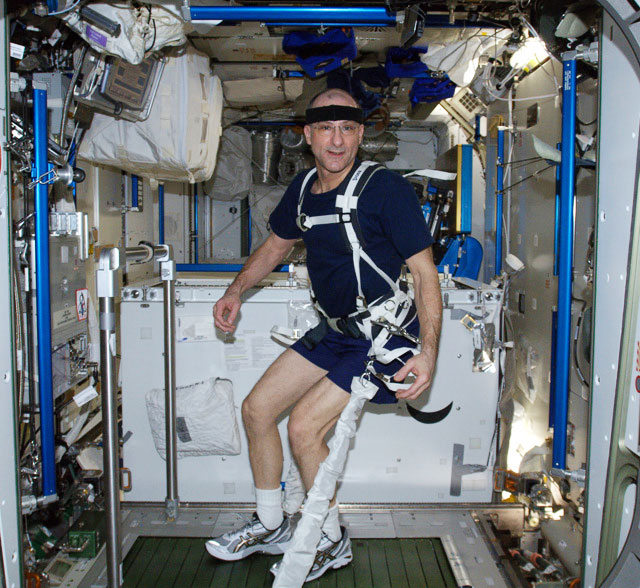Humans make rather poor beasts of burden. Fortunately, nowadays heavy loads are pretty much relegated to machines, saving our spines for recreational activities like donning backpacks and heading into the wilderness. Speaking of which, the suspension system for backpacks—the part that connects the load to our bodies through a series of straps—is relevant to our attempts to keep our muscles and bones from degenerating in space.
To maintain our muscles, bones, and cardiovascular systems, we exercise about two and a half hours each day. These exercises are divided between resistance (“weightlifting” in weightlessness), cycling, and treadmill routines. To run on the treadmill in zero-g requires that your feet stay in contact with the belt, so we wear a backpack harness with adjustable spring-loaded straps. The loading is important. To reap the full health benefit, the harness is loaded to near (Earth) body weight, which for me is 80 kilograms (176 pounds). It sounds easy, but the technical details of creating a harness add significant complexity to the process of exercise in space. This is another example in spaceflight hardware design where the answers are not in the back of the book.

On Earth, a backpack harness is designed to distribute the load between the shoulders and hips, with the balance between the two usually adjustable. And no one really wants to carry a backpack weighing more than about 80 pounds. I have a minimalist philosophy when it comes to backpacking, and seldom carry more than about 45 pounds.
Now enter the space requirement to carry a load close to your body weight. No backpack I am aware of is designed to do this. And how does one best distribute the load between hips and shoulders? Our bodies are not meant to carry our own weight on our shoulders, so the load has to be distributed more widely. But since the spine has to be loaded, too, the entire weight cannot be placed on the hips. Your hips also have to be free to swing with your stride.
When backpacking with heavy loads on Earth, we seldom work near maximum cardiovascular levels. Backpacking is slow and easy; we take the time to smell the roses along the wilderness trail. In space, we run on a treadmill at 95 percent of our maximum heart rate. At this level of exertion, your chest is expanding and contracting to its full extent while your heart feels like it is going to jump out of your chest. Normal backpacks are not designed to accommodate the required chest expansion at maximum exertion.
These seemingly small engineering details complicate the backpack design enough that we can’t just use off-the-shelf equipment. The treadmill harness we use on Space Station was engineered at NASA Glenn Research Center, and so is called the Glenn harness. The engineering was tested on Earth by taking a treadmill and mounting it vertically on a wall. Then the test subject (I was one of them) is suspended horizontally above the floor with a series of bungees, like in a magician’s floating lady act. Now the harness can be tested at near-body-weight loads in normal gravity. It’s often necessary to go to such lengths to design and test spaceflight hardware. In that way, a large visionary technology program like Space Station drives numerous small advances that never would have been contemplated (or funded) without the greater driving force.
Don’s blog also appears at airspacemag.com.

Just saw the ISS pass over Annapolis, Maryland. How fabulous to know there are people inside that little point of light. Thank you for your work and for being the pioneers that you are.
hi keep up the execising bet your all dying for a cooked dinner bless you all i admire you all love nanny sue from wales xxxxxx
boros sir.saturday.
Ideally, you guys should run on this treadmill while lifting with your arms another person’s sprung weight, like the porters of a sedan chair, in addition to the back packs sprung weight (which represents your own weight). This would effectively double the load-bearing forces, rendering a more effective muscle-toning exercise, as well as involving the arms, which suffer greatly during an extended space mission. Similarly, the head band could also be equipped with a gentle spring pushing down from the ceiling to tone the neck muscles during the run.
By engaging a full compliment of muscles, the astronaut is better prepared to return to earth, and knows it, making them feel emotionally better prepared as well. This is essential to the emotional as well as physical well-being of all medium to long term space visitors. This is particularly important as we move towards not just groups of astronauts but individuals as well who acquire vital long term experience in space, and results in insights as yet untouched by the human mind.